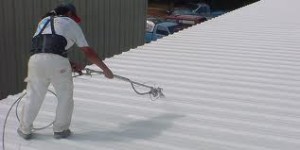Elastomeric Paint Application on Roofs
When paint begins wearing off the surfaces it is on, the structure underneath will often crack. This is especially true with wood and stucco. Stone and metal can also crack, and any exposed  metal may become rusty over time. Another type of material that is notorious for cracking is T-111 siding. Some people try to fill cracks with caulk, paint or other substances. However, the underlying damage still exists. The ideal solution is to prevent that damage in the first place. One of the easiest ways to do this is to use elastomeric paint. It is also known as rubberized paint, because it leaves a rubbery surface that is tough and water resistant.
metal may become rusty over time. Another type of material that is notorious for cracking is T-111 siding. Some people try to fill cracks with caulk, paint or other substances. However, the underlying damage still exists. The ideal solution is to prevent that damage in the first place. One of the easiest ways to do this is to use elastomeric paint. It is also known as rubberized paint, because it leaves a rubbery surface that is tough and water resistant.
What Is Elastomeric Paint
This type of paint is very thick and has unique elongation capabilities, which means it can repair hairline cracks and bridge slightly larger ones. People who have stucco or wood surfaces that are cracked often choose this type of paint rather than replacing the cracked materials. With this type of paint, there is no need for many coats. Two coats over primer is enough to repair minor cracks and prevent water from entering. This form of paint is also long lasting. While a good acrylic paint may last about 10 years in favorable conditions, this form of coating will last much longer.
How Much Does It Cost?
As it is with anything of higher quality, the price will be reflective. In comparison with the cost of regular paint, this type costs about 50 percent more overall. The higher price is due to a smaller spread rate and the rising cost of paint per gallon. Although it is more expensive than most other paints used in or on a home, it does last longer and is not so expensive that it is not affordable. It is one of the most favored rubber roofing materials, and is sometimes considered a liquid rubber roof compound. As metal roof paint, it stands up better to temperature changes and direct sunlight. Over time, most paints crack in the sun or due to significant temperature changes. However, the elasticity in this type of coating that makes it unique also makes it more resistant to seasonal changes.
Many home and business owners consider this rubbery paint an investment. For example, a person could use this type of paint for about the same price as what it would cost to fill cracks and deal with peeling acrylic paint repeatedly for the same amount of time. It is also important to remember that peeling paint over a damaged surface will lead to further damage. Repeatedly repainting a surface that is cracked and eventually peels again will lead to quicker wear of the underlying material, which is far more expensive to replace than paint. Only an experienced professional should apply elastomeric paint to a surface. Coatings can be applied using rollers or airless sprayers. It is easy to see why so many people are choosing this type of paint. In comparison with the best acrylic paint, it is durable enough that it can outperform any acrylic paint two to one.